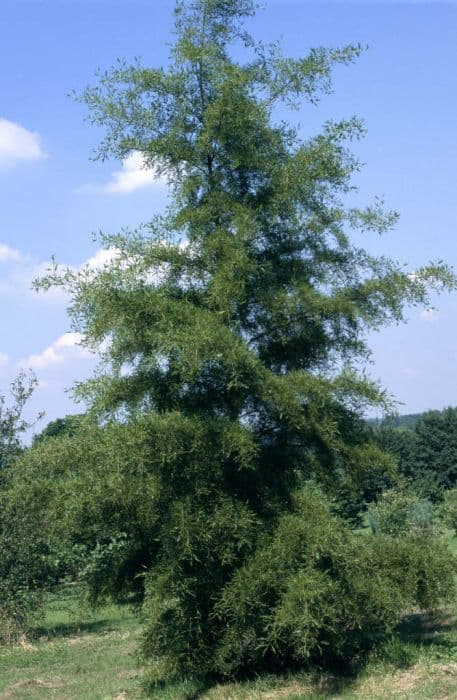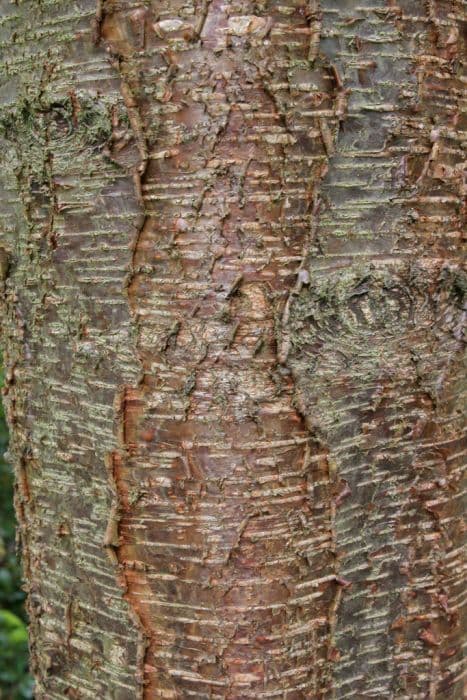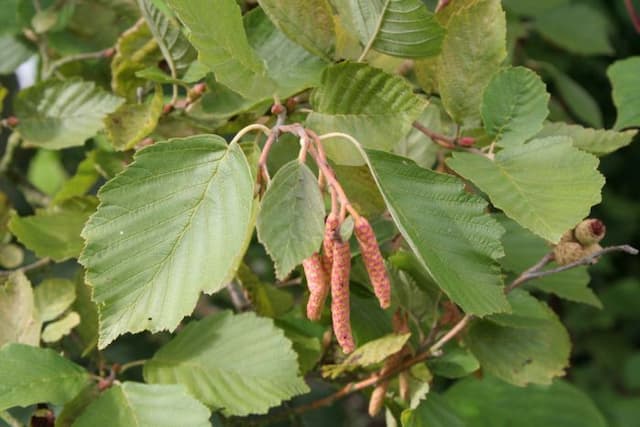Italian alder Alnus cordata

ABOUT
A. cordata is a vigorous deciduous medium-sized tree with shiny deep green leaves. Male catkins yellow, to 10cm in length. Fruit 2.5cm in length, cone-like
About this plant
 Names
NamesFamily
Betulaceae
Synonyms
Italian Alder, Heart-leaved Alder
Common names
Alnus cordata.
 Characteristics
CharacteristicsLife cycle
Perennials
Foliage type
Deciduous
Color of leaves
Green
Flower color
Yellow
Height
50 feet [15 meters]
Spread
30 feet [9 meters]
Plant type
Tree
Hardiness zones
6
Native area
Mediterranean
Benefits
 General Benefits
General Benefits- Erosion Control: Alnus cordata's extensive root system helps to stabilize soil and prevent erosion, particularly along riverbanks and in wetlands.
- Nitrogen Fixation: Italian Alder hosts nitrogen-fixing bacteria, which can enrich poor soils by naturally adding nitrogen, an essential plant nutrient.
- Ornamental Value: With its heart-shaped leaves and attractive catkins, Italian Alder is often used in landscaping for its decorative appeal.
- Wildlife Habitat: The tree provides shelter and food for a variety of wildlife, including birds and insects.
- Fast Growth: Italian Alder is a fast-growing species, which makes it suitable for quick establishment and landscaping projects.
- Adaptability: It adapts well to a range of soil types, including those that are wet or otherwise difficult for other species, and is quite tolerant of urban pollution.
- Wood Production: Italian Alder produces wood that can be used in furniture making, veneer production, and as a source of pulp for paper manufacturing.
- Streambank Stabilization: Its use along streams and waterways can help reduce bank erosion and protect aquatic environments.
- Windbreak: When planted in rows, Italian Alder can act as a windbreak, providing protection for crops, soil, and smaller plants from strong winds.
- Honey Production: Bees are attracted to the flowers of Alnus cordata, making it beneficial for honey production.
 Medical Properties
Medical PropertiesThis plant is not used for medical purposes.
 Air-purifying Qualities
Air-purifying QualitiesThis plant is not specifically known for air purifying qualities.
 Other Uses
Other Uses- Wetland restoration: Alnus cordata, commonly known as the Italian alder, is used in wetland restoration projects due to its ability to thrive in damp conditions and improve soil quality through nitrogen fixation.
- Woodworking: The light yet resilient wood of the Italian alder is utilized in crafting furniture and turned objects, valued for its workability and fine grain.
- Erosion control: Its extensive root system makes it effective for stabilizing stream banks and preventing soil erosion in vulnerable areas.
- Biomass production: Due to its rapid growth, the Italian alder can be harvested for biomass, providing a renewable source of energy.
- Dye production: The bark of the Italian alder contains tannins which can be used to produce dyes for textiles and leather products.
- Landscape gardening: Its ornamental value is admired in landscape design for its attractive conical shape and vibrant green foliage.
- Wildlife habitat: The Italian alder provides habitat and food for various birds and insects, enhancing biodiversity in both natural and urban settings.
- Windbreaks and shelterbelts: Planted in rows, the Italian alder can act as a windbreak or shelterbelt to protect crops and reduce wind erosion on farmlands.
- Stream purification: The species can play a role in biofiltration and stream purification by absorbing excess nutrients and pollutants from the water.
- Agroforestry systems: Italian alder's compatibility with agricultural crops makes it suitable for intercropping in agroforestry systems, promoting ecological diversity and soil health.
Interesting Facts
 Feng Shui
Feng ShuiThe Italian Alder is not used in Feng Shui practice.
 Zodiac Sign Compitability
Zodiac Sign CompitabilityThe Italian Alder is not used in astrology practice.
 Plant Symbolism
Plant Symbolism- Protection: The Italian alder has been historically regarded as a protective tree. Its ability to grow fast and strong was seen as a protective barrier against natural elements.
- Resilience: Italian alders are known to tolerate poor soil conditions and water, symbolizing the ability to thrive in adverse conditions.
- Strength: The wood of the Italian alder is robust and durable, often used in construction, representing physical strength.
- Adaptability: Italian alders adapt to their environment by fixing nitrogen in the soil, which symbolizes flexibility and the capacity to improve and adjust to surroundings.
- Prosperity: Because alders enhance soil fertility, they are associated with bringing prosperity and abundance to the land and those who cultivate it.
 Water
WaterItalian Alder, or Alnus cordata, prefers moist soils but is also adaptable to different moisture levels once established. During its initial growth years and in the absence of rain, water the Italian Alder every week, aiming for about 1 to 1.5 inches of water to ensure a steady supply of moisture to the roots. For established trees, reduce watering frequency but ensure the tree receives deep watering during prolonged dry spells. As a guideline, you can provide approximately 15 to 20 gallons of water during these periods to maintain soil moisture.
 Light
LightItalian Alder thrives in full sun to partial shade conditions. The best spot for an Italian Alder would be an open area where it can receive at least six hours of direct sunlight daily while also tolerating some light shade.
 Temperature
TemperatureItalian Alder is hardy in a range of temperatures, being able to survive in winter conditions as cold as -4°F and is comfortable in temperatures up to 95°F. The ideal growing conditions for the Italian Alder are between 40°F and 75°F, which promotes optimal growth and development.
 Pruning
PruningPruning Italian Alder is mainly necessary to remove any damaged or diseased branches, to shape the tree during its formative years, or to maintain a safe structure. The best time to prune is late winter or early spring before new growth starts. Generally, pruning can be done every two to three years or as needed to remove unwanted growth.
 Cleaning
CleaningNot needed
 Soil
SoilItalian Alder prefers moist, well-draining soil with a pH ranging from slightly acidic to neutral. A mixture of loamy soil with organic compost and peat is ideal for nurturing growth and vitality.
 Repotting
RepottingItalian Alders are typically outdoor trees and do not require repotting. If planted in a container, young trees should be repotted every two to three years into larger pots to accommodate root growth.
 Humidity & Misting
Humidity & MistingItalian Alder is adaptable to a wide range of humidity levels and does not require specific humidity conditions to thrive, making it suitable for various outdoor environments.
 Suitable locations
Suitable locationsIndoor
Not suited for indoor growth; requires ample space.
Outdoor
Plant in moist soil; full sun to partial shade.
Hardiness zone
6-9 USDA
 Life cycle
Life cycleThe Italian Alder (Alnus cordata) begins its life cycle when seeds are dispersed from mature cones, typically carried by wind or water. The seeds germinate in moist soil conditions, often near bodies of water, and develop into seedlings with a rapid initial growth rate. As a fast-growing tree, the Italian Alder quickly establishes a deep root system and begins forming a straight trunk with a conical crown, progressing from a juvenile into a mature tree within a few years. It reaches reproductive maturity around the age of 5 to 7 years, when it starts producing both male and female catkins; the male catkins release pollen, which fertilizes the female catkins leading to seed development. Throughout its lifespan, which can extend up to 50 years or more, the Italian Alder continues this annual reproductive cycle. The tree eventually enters senescence, its growth slows, and it ultimately dies, at which point its decaying matter returns nutrients to the soil, supporting new plant growth.
 Propogation
PropogationPropogation time
Early spring
The most popular method of propagation for Alnus cordata, commonly known as Italian Alder, is by seed. The best time to collect seeds is in autumn after they mature, which generally happens from September to November. To propagate Italian Alder by seeds, one should first stratify the seeds at a temperature of around 40 degrees Fahrenheit (4.44 degrees Celsius) for approximately one to two months to overcome dormancy. After stratification, seeds can be sown in well-drained soil in a cold frame or a sheltered outdoor seedbed during spring. Germination can be expected within a month, after which seedlings can be grown on in pots before being transplanted to their final position once they are sufficiently robust.









